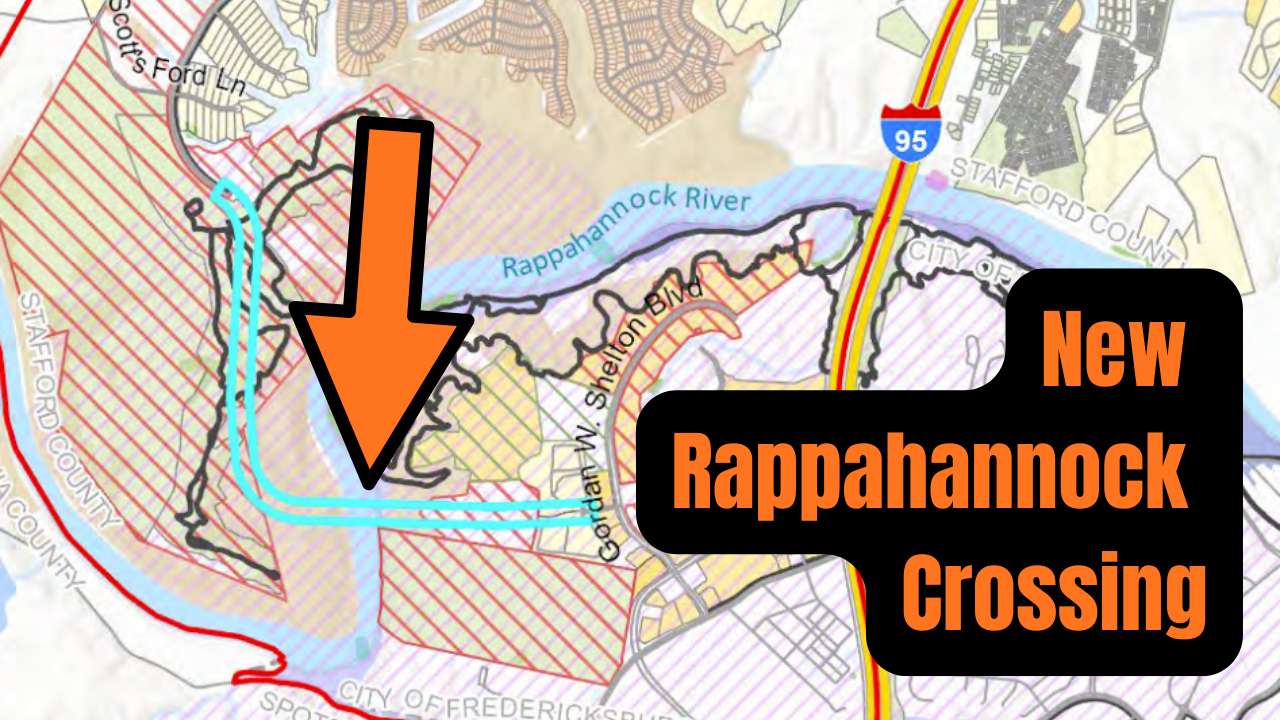
The Fredericksburg Area Metropolitan Planning Organization voted Monday to adopt the long-awaited Rappahannock River Crossing Parkway Alternatives Study, advancing “Option C,” a proposed new bridge and roadway linking Stafford County to the City of Fredericksburg west of Interstate 95.
The decision places the corridor into the region’s long-range transportation plan and moves the project toward the costly federal environmental review process needed before any construction can be approved.
The November 24 vote came by voice vote, not roll call. Several members voiced opposition, but the motion passed.
Bridge Would Create New Stafford–Fredericksburg Link
Option C, the preferred alternative identified in the study, would create a new north–south connection running west of I-95, crossing the Rappahannock River and tying Stafford’s western road network more directly to Fredericksburg. Regional planners say the corridor would reduce traffic on Route 3, Route 17, and portions of I-95 by giving commuters and emergency responders a new path across the river.
The study places the planning-level construction cost at roughly $203.8 million.
While Monday’s vote does not authorize construction, it allows the project to enter the federal National Environmental Policy Act (NEPA) review — estimated at up to $25 million — if funding can be secured.
Funding Questions Loom Large
Stafford Supervisor Meg Bohmke pressed FAMPO staff on how the region plans to fund the NEPA phase if a recently submitted federal BUILD grant — which requires no local match — is unsuccessful. Staff outlined backup options including splitting the project into phases for SMART SCALE scoring, requesting support from the Commonwealth Transportation Board, or turning to local bond financing.
Representatives from Spotsylvania County voiced some of the strongest opposition to adopting the west-side Rappahannock River Crossing study. During the Nov. 24 FAMPO meeting, Spotsylvania members reiterated that their Board of Supervisors had formally voted to oppose the corridor, and they carried that directive into the regional vote.
One Spotsylvania representative reminded the committee that their county’s stance had not changed and said they would not support advancing Option C. Their objections centered on new traffic patterns, impacts on neighborhoods, and whether the project would primarily benefit Stafford and Fredericksburg at Spotsylvania’s expense. Despite the county’s continued resistance, the study was adopted by the regional body through a voice vote.
Only one resident, Allen Watkins, spoke in person, raising concerns about cultural sites, environmental impacts, and the size of the 747-page technical report. Several letters were read into the record, including one supporting Option C and referencing a petition with more than 3,300 signatures, and others opposing the project on environmental or traffic grounds.
Yeung Criticizes West-Side Crossing, Prefers Dahlgren Bridge
Just six days before the FAMPO vote, Stafford Garrisonville District Supervisor Pamela Yeung publicly criticized the west-side river crossing during the November 18, 2025 Stafford County Board of Supervisors meeting.
Yeung argued a new bridge connecting Stafford directly to Fredericksburg would “send money out of the county” and said Garrisonville, which she represents, would “take the brunt” of any new traffic generated by the project.
Instead, Yeung said she prefers a river crossing at Route 301 in Dahlgren — more than 30 miles east — and wants the state or federal government, not Stafford residents, to pay for it. She also emphasized environmental conditions, including strong stormwater protections, no piers in the river, and a “full-span” bridge design.
Her comments place her at odds with other Stafford leaders. The county’s representatives on FAMPO — including Bohmke — have supported moving the study forward, and Stafford’s Board previously voted to endorse Option C.
FAMPO is now awaiting word on its federal BUILD grant request. If the grant is awarded, the NEPA study would launch next year and is expected to take multiple years. The CTAC-recommended alignment — an alternative western variant — is also expected to return to a future FAMPO agenda and could influence the final layout.


